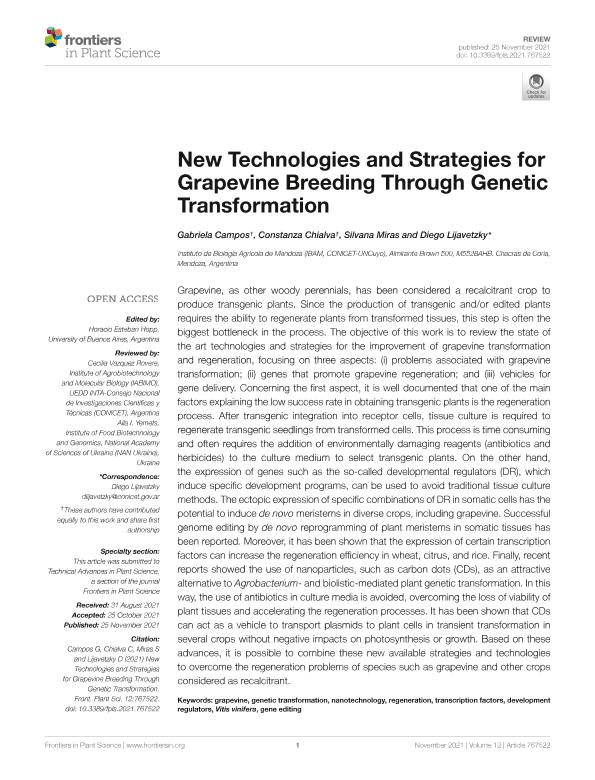Mostrar el registro sencillo del ítem
dc.contributor.author
Campos, Gabriela Natalia

dc.contributor.author
Chialva, Constanza Soledad

dc.contributor.author
Miras, Silvana

dc.contributor.author
Lijavetzky, Diego Claudio

dc.date.available
2021-12-20T12:41:05Z
dc.date.issued
2021-11
dc.identifier.citation
Campos, Gabriela Natalia; Chialva, Constanza Soledad; Miras, Silvana; Lijavetzky, Diego Claudio; New technologies and strategies for grapevine breeding through genetic transformation; Frontiers Media; Frontiers in Plant Science; 12; 11-2021; 1-17
dc.identifier.issn
1664-462X
dc.identifier.uri
http://hdl.handle.net/11336/149006
dc.description.abstract
Grapevine, as other woody perennials, has been considered a recalcitrant crop to produce transgenic plants. Since the production of transgenic and/or edited plants requires the ability to regenerate plants from transformed tissues, this step is often the biggest bottleneck in the process. The objective of this work is to review the state of the art technologies and strategies for the improvement of grapevine transformation and regeneration, focusing on three aspects: (i) problems associated with grapevine transformation; (ii) genes that promote grapevine regeneration; and (iii) vehicles for gene delivery. Concerning the first aspect, it is well documented that one of the main factors explaining the low success rate in obtaining transgenic plants is the regeneration process. After transgenic integration into receptor cells, tissue culture is required to regenerate transgenic seedlings from transformed cells. This process is time consuming and often requires the addition of environmentally damaging reagents (antibiotics and herbicides) to the culture medium to select transgenic plants. On the other hand, the expression of genes such as the so-called developmental regulators (DR), which induce specific development programs, can be used to avoid traditional tissue culture methods. The ectopic expression of specific combinations of DR in somatic cells has the potential to induce de novo meristems in diverse crops, including grapevine. Successful genome editing by de novo reprogramming of plant meristems in somatic tissues has been reported. Moreover, it has been shown that the expression of certain transcription factors can increase the regeneration efficiency in wheat, citrus, and rice. Finally, recent reports showed the use of nanoparticles, such as carbon dots (CDs), as an attractive alternative to Agrobacterium- and biolistic-mediated plant genetic transformation. In this way, the use of antibiotics in culture media is avoided, overcoming the loss of viability of plant tissues and accelerating the regeneration processes. It has been shown that CDs can act as a vehicle to transport plasmids to plant cells in transient transformation in several crops without negative impacts on photosynthesis or growth. Based on these advances, it is possible to combine these new available strategies and technologies to overcome the regeneration problems of species such as grapevine and other crops considered as recalcitrant.
dc.format
application/pdf
dc.language.iso
eng
dc.publisher
Frontiers Media

dc.rights
info:eu-repo/semantics/openAccess
dc.rights.uri
https://creativecommons.org/licenses/by-nc-sa/2.5/ar/
dc.subject
DEVELOPMENT REGULATORS
dc.subject
GENE EDITING
dc.subject
GENETIC TRANSFORMATION
dc.subject
GRAPEVINE
dc.subject
NANOTECHNOLOGY
dc.subject
REGENERATION
dc.subject
TRANSCRIPTION FACTORS
dc.subject
VITIS VINIFERA
dc.subject.classification
Otras Ciencias Biológicas

dc.subject.classification
Ciencias Biológicas

dc.subject.classification
CIENCIAS NATURALES Y EXACTAS

dc.title
New technologies and strategies for grapevine breeding through genetic transformation
dc.type
info:eu-repo/semantics/article
dc.type
info:ar-repo/semantics/artículo
dc.type
info:eu-repo/semantics/publishedVersion
dc.date.updated
2021-12-03T20:08:21Z
dc.journal.volume
12
dc.journal.pagination
1-17
dc.journal.pais
Suiza

dc.description.fil
Fil: Campos, Gabriela Natalia. Consejo Nacional de Investigaciones Científicas y Técnicas. Centro Científico Tecnológico Conicet - Mendoza. Instituto de Biología Agrícola de Mendoza. Universidad Nacional de Cuyo. Facultad de Ciencias Agrarias. Instituto de Biología Agrícola de Mendoza; Argentina
dc.description.fil
Fil: Chialva, Constanza Soledad. Consejo Nacional de Investigaciones Científicas y Técnicas. Centro Científico Tecnológico Conicet - Mendoza. Instituto de Biología Agrícola de Mendoza. Universidad Nacional de Cuyo. Facultad de Ciencias Agrarias. Instituto de Biología Agrícola de Mendoza; Argentina
dc.description.fil
Fil: Miras, Silvana. Consejo Nacional de Investigaciones Científicas y Técnicas. Centro Científico Tecnológico Conicet - Mendoza. Instituto de Biología Agrícola de Mendoza. Universidad Nacional de Cuyo. Facultad de Ciencias Agrarias. Instituto de Biología Agrícola de Mendoza; Argentina
dc.description.fil
Fil: Lijavetzky, Diego Claudio. Consejo Nacional de Investigaciones Científicas y Técnicas. Centro Científico Tecnológico Conicet - Mendoza. Instituto de Biología Agrícola de Mendoza. Universidad Nacional de Cuyo. Facultad de Ciencias Agrarias. Instituto de Biología Agrícola de Mendoza; Argentina
dc.journal.title
Frontiers in Plant Science
dc.relation.alternativeid
info:eu-repo/semantics/altIdentifier/doi/http://dx.doi.org/10.3389/fpls.2021.767522
dc.relation.alternativeid
info:eu-repo/semantics/altIdentifier/url/https://www.frontiersin.org/articles/10.3389/fpls.2021.767522/full
Archivos asociados
